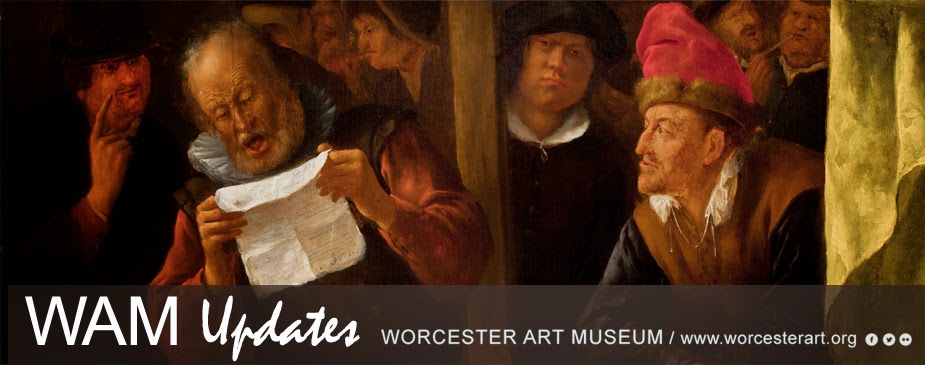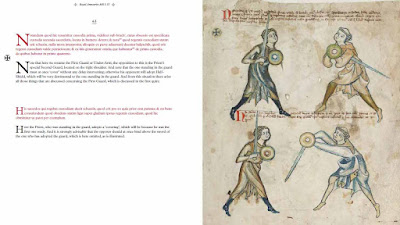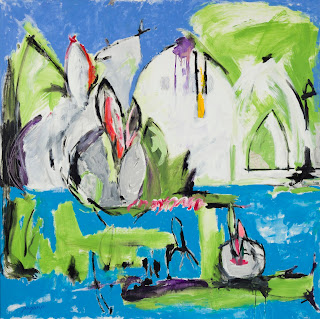
Gallery 211, a small room along the Renaissance Court balcony, has long held the latest pieces in our European collection chronologically — paintings from the late 19th and early 20th centuries. Those visiting the gallery today will find it somewhat changed. The yellow-white walls have been repainted a deep blue. Alongside old favorites like Monet’s Waterlilies and Gauguin’s Te Faaturuma (The Brooding Woman) hang pieces that have long been out of view, including works by Renoir and Cézanne. Nearest the door hangs a small painting of brightly colored houses with a simple black frame. Modest as it may seem, this new acquisition is the inspiration for the gallery’s reinstallation.
“It was serendipity,” says Claire Whitner, Director of
Curatorial Affairs and James A. Welu Curator of European Art. The Museum had already begun the process of acquiring Häuser in Riegsee (Houses in Riegsee) by Gabriele Münter when Claire joined WAM in August, but as a specialist in
German Modernism, she was immediately drawn to it. “The more I thought about it, the more I
realized it was the perfect fit.”
Gabriele Münter, one of only three female artists currently
on display in the European galleries, was a prominent member of Der Blaue Reiter (The Blue Rider), a
group of German artists active in Munich in the early 20th
century. Like all artists, she did not
work in isolation, drawing inspiration from other artists of her time. Claire sees in Häuser in Riegsee not just another experimental landscape, but also an avant-garde use of paint and light, the strong outlines
of Paul Gauguin, and the bright palette favored by Fauvist artists.* “Münter merges all these elements in her
work, making it something more transitional, moving towards expressionism.”
 |
| Claire Whitner, Director of Curatorial Affairs and James A. Welu Curator of European Art, stands next to the new Münter painting. |
When choosing which paintings would accompany Münter’s,
Claire hoped to be able to show how the artists of the early 20th
century worked together and fed off each other.
“I tried to find works that speak to each other and put them into a
dialogue, rather than having each work stand in isolation.” Using WAM’s strong collection of late 19th
and early 20th century art, Claire was able to pull together a
stunning range of artwork, some quite different from others, but all sharing a
common thread of mutual inspiration.
Doing so also meant narrowing the time period on
display. Notably, Untitled, No. 629 by Vassily Kandinsky has been relocated to the
Sidney and Rosalie Rose Gallery on the Upper 3rd Floor. Münter had been Kandinsky’s student, and the
two had shared a professional and personal relationship, but WAM’s
Kandinsky comes from a very different time period – 1936, while the rest of the
gallery is pre-World War I.
“World War I marks a dramatic break in the kind of artwork produced in Europe,” Claire
explains, when many avant-garde artists were sent off to war; Kandinsky was
forced to leave Germany and return to Russia.
The War itself lead to changes in
how the artists saw the world. “They had
to adapt to the horror of the War, and they began to develop in new
directions.” For Kandinsky, this meant
increasingly abstract art; for others, it meant turning to more
emotionally wrought modes of representation.
Which leaves one last question: why choose blue for the
gallery walls? “The Blaue Reiter artists felt that blue was the most emotional and
mystical color,” Claire explains. She
also found that each of the pieces chosen for the gallery includes some blue,
though all in different shades, and some as only a highlight. The blue walls help to draw these out,
unifying the artwork, and also allowing the viewer to appreciate the colors in
a new way. “There are shades of teal in
Münter’s painting that I never noticed before,” she says. Such a bold choice is especially suitable to
a gallery of avant-garde artists, tying into the experiments with color so
popular in the early 20th century.
 |
| Gabriele Münter (German, 1877-1962), Häuser in Riegsee (Houses in Riegsee), 1909, oil on cardboard, Stoddard Acquisition Fund, 2018.40 |
*The Fauvists were a group of early 20th century French
artists who emphasized bright colors and often wild, experimental brush
work. Henri Matisse was a leader in this
movement.
- Sarah Leveille, Worcester Art Museum




























